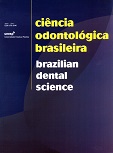Influência do pré-estiramento nas forças geradas por elásticos ortodônticos em cadeia
DOI:
https://doi.org/10.14295/bds.2008.v11i3.505Abstract
ResumoO objetivo deste estudo foi avaliar a influência dos procedimentos de estiramento de forma única e múltipla nas velocidades de 5,0 mm/minuto e 50,0 mm/minuto no grau de degradação da força gerada por elásticos em cadeia na cor cinza da marca comercial American Orthodontics . Os elásticos foram estirados em uma máquina de ensaios de tração e pelo método manual com pinça de separação e mantidos imersos em água destilada, onde permaneceram distendidos em 50% de seus comprimentos por 48 horas. Tiveram suas forças medidas em uma máquina de ensaios de tração (EMIC-DL 500 MF célula 1 Kgf) e os resultados oram gerados por um computador conectado à máquina de tração e foram submetidos a testes estatísticos (ANOVA e GLIM) com p < 0,05. Os resultados demonstraram que não houve diferença estatisticamente significativa em relação ao método de estiramento realizado de forma única e múltipla e em relação à velocidade de estiramento realizada de forma enta e rápida. Foram encontradas diferenças significativas com maior degradação da força para os elásticos estirados em máquina de ensaio de tração em relação aos estirados pelo método manual com pinça de separação com p < 0,001. Concluiu-se que em termos práticos, o procedimento de pré-estiramento dos elásticos em cadeia poderá ser realizado de forma única e na velocidade rápida e que o método de estiramento manual com pinça de separação mostrou-se efetivo, liberando forças nos níveis aceitáveis clinicamente para a movimentação dentária.
Downloads
Downloads
Published
How to Cite
Issue
Section
License
Brazilian Dental Science uses the Creative Commons (CC-BY 4.0) license, thus preserving the integrity of articles in an open access environment. The journal allows the author to retain publishing rights without restrictions.
=================




























